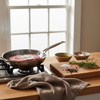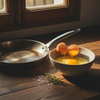Solid Spoon for Stirring and Mixing: The Complete Guide
Key Takeaways
- A solid spoon is essential for achieving smooth and consistent mixtures in cooking.
- It plays a crucial role in both everyday meals and special occasion dishes.
- Despite its simplicity, the solid spoon is a key tool for culinary success.
- This utensil helps prevent common cooking mistakes like lumps and deflated batters.
Table of Contents
- Why the Right Solid Spoon Matters in Every Kitchen
- What Makes a Solid Spoon for Stirring and Mixing Unique?
- The Science of Stirring, How Spoon Construction Impacts Results
- Materials Showdown, Should You Choose Silicone, Wood, or Stainless Steel?
- Choosing the Right Solid Spoon for Your Cooking Task
- How to Use a Solid Spoon Like a Pro, Techniques for Perfect Stirring and Mixing
- Care, Cleaning, and Maintenance, Maximizing Your Spoon's Life
- DI ORO's Award-Winning Solid Spoons, Innovation, Health, and Joy in Every Stir
- Solid Spoon FAQs, Quick Solutions to Common Stirring and Mixing Questions
- Making the Right Choice for Your Kitchen
Why the Right Solid Spoon Matters in Every Kitchen
A solid spoon for stirring and mixing is the unsung hero of culinary creativity, the difference between silky béchamel and lumpy disappointment, between perfectly folded soufflé batter and deflated dreams. While flashier gadgets grab attention, this essential tool quietly enables everything from weeknight stir-fries to holiday feast preparations. A seamless spatula set can also elevate your kitchen efficiency, offering versatility for a range of stirring and mixing tasks.
For those who want to master both stirring and serving, understanding the differences between a fork and spoon can help you choose the right utensil for every recipe. Investing in high-quality tools ensures your mixtures are always smooth and consistent.
What Makes a Solid Spoon for Stirring and Mixing Unique?

Unlike slotted spoons that drain liquids or serving spoons designed for portioning, a solid spoon features an uninterrupted bowl surface that moves ingredients efficiently without separation. The seamless, one-piece construction eliminates bacteria-harboring joints found in traditional wooden spoons with glued handles.
Professional-grade solid spoons measure 12-14 inches in length for optimal reach into deep pots, with bowl depths ranging from 0.75 to 1.25 inches depending on intended use. The edge profile, whether rounded for gentle folding or slightly flattened for scraping, determines mixing effectiveness.
Material choice defines performance: pro-grade silicone withstands 600°F while protecting nonstick surfaces, stainless steel offers durability but conducts heat dangerously, and wood provides tradition but requires constant maintenance. DI ORO's seamless silicone design, recognized by America's Test Kitchen as the most versatile on the market, exemplifies how thoughtful construction elevates everyday cooking into professional-level results.
The Science of Stirring, How Spoon Construction Impacts Results
Bowl curvature directly affects mixing efficiency, a gentle curve creates laminar flow that prevents lumps in béchamel, while deeper bowls move more volume per stir, reducing mixing time by up to 40%. The edge design matters equally: rounded edges fold delicate batters without deflating air bubbles, while slightly flattened edges scrape pan bottoms completely clean.
Handle weight distribution determines comfort and control. Optimal balance requires 2-3 ounces of weight concentrated in a stainless steel core, preventing wrist fatigue during extended mixing sessions. Lightweight plastic handles cause overcompensation and uneven stirring patterns.
Pro Tip: Seamless construction eliminates the microscopic crevices where bacteria multiply, a critical advantage when switching between raw and cooked ingredients during complex recipes.
Heat conduction varies dramatically by material. While stainless steel spoons can reach dangerous temperatures within seconds, pro-grade silicone remains cool to touch even during high-heat caramel making, preventing burns and maintaining precise control throughout the cooking process. For more on the science behind silicone, see this comprehensive overview of silicone.
Materials Showdown, Should You Choose Silicone, Wood, or Stainless Steel?
Material selection determines safety, durability, and cooking performance across different techniques and temperatures.
| Material | Heat Resistance | Cookware Safety | Maintenance | Lifespan |
|---|---|---|---|---|
| Pro-Grade Silicone | 600°F continuous | Nonstick-safe | Dishwasher safe | 10+ years |
| Stainless Steel | 1000°F+ (handle burns) | May scratch coatings | Hand wash recommended | Lifetime |
| Hardwood | 400°F (scorching risk) | Nonstick-safe | Monthly oiling required | 3-5 years |
Forever-chemical contamination poses hidden risks in lower-grade silicone products. DI ORO's LFGB-certified, BPA-free silicone eliminates these concerns while delivering superior heat resistance and seamless hygiene. Wood requires quarterly mineral oil treatments and harbors odors, while stainless steel conducts heat dangerously during stovetop cooking.
For versatility across all cooking methods, from delicate custards to high-heat sautéing, pro-grade silicone with stainless steel core construction offers unmatched performance without compromise. If you're interested in exploring more about silicone spatulas for mixing and scraping, check out this helpful guide.
Choosing the Right Solid Spoon for Your Cooking Task

Size and Length, How to Match Spoon to Task
Stovetop sautéing requires 10-12 inch spoons for maneuverability, while soup pots and stock preparation demand 14-inch handles for reach and safety. Bowl depth matters equally, shallow bowls excel at delicate sauce work and deglazing, while deeper bowls handle thick batters and chunky stews without spillage.
For precision baking tasks like folding meringue or combining delicate batters, choose spoons with narrower bowls (2-3 inches) that won't deflate your carefully whipped mixtures. Heavy-duty cooking spoons with wider bowls (3-4 inches) power through dense cookie doughs and thick risottos without bending.
Handle Ergonomics & Storage Features
A balanced core prevents wrist fatigue during extended mixing sessions. DI ORO's stainless steel core design distributes weight evenly, eliminating the wobble common in hollow handles. Anti-slip grips become essential when working with oils or wet ingredients, silicone naturally provides superior grip compared to smooth stainless steel.
Storage matters for daily use. Hanging loops save drawer space, while flat-edge designs stack efficiently. Heat-resistant handles prevent burns when resting spoons on hot cookware, a critical safety feature that separates professional-grade tools from basic options. For more on the benefits of heat resistant silicone spoons for cooking, see this in-depth article.
How to Use a Solid Spoon Like a Pro, Techniques for Perfect Stirring and Mixing
Stirring Basics (and How to Avoid Lumps)
Master the figure-8 motion for smooth sauces: start at the pan's edge, sweep across the bottom, up the opposite side, and back through the center. This technique, recommended by culinary schools, prevents lumps in 30-60 seconds of consistent motion. The key is maintaining contact with the pan bottom while keeping movement fluid.
For thick mixtures like scrambled eggs or polenta, use gentle back-and-forth scraping motions. DI ORO's seamless silicone edge design prevents scratching while effectively moving ingredients from pan edges where sticking occurs most frequently. If you want a versatile tool for these tasks, consider the 4-piece seamless spatula set for both mixing and scraping.
Folding, Blending, and Combining
Proper folding preserves air in delicate batters through the "down, across, up" method. Insert your solid spoon for stirring and mixing vertically into the batter center, sweep across the bottom, lift up the side, and fold over, repeat in 10-12 gentle passes maximum. This technique maintains volume in soufflés and prevents tough muffins.
For bread doughs and thick cookie batters, leverage your spoon's core strength. Press and turn rather than stirring to distribute ingredients without overworking gluten development.
Care, Cleaning, and Maintenance, Maximizing Your Spoon's Life
Wash within 10 minutes of use to prevent staining, especially with tomato-based sauces or turmeric-heavy dishes. Silicone spoons handle dishwasher cycles safely, while wooden options require hand-washing to prevent cracking. For stubborn odors in silicone, create a paste with baking soda and water, let sit for 30 minutes, then rinse thoroughly.
DI ORO's seamless construction eliminates bacteria-harboring crevices found in traditional joined handles. The pro-grade silicone resists staining and maintains flexibility even after hundreds of dishwasher cycles. Should any issues arise, their replacement guarantee provides peace of mind, "you break it, we replace it." For additional information on hygiene and food safety, see this peer-reviewed article on kitchen utensil hygiene.
Pro Maintenance Tip: Store spoons with bowls facing up to prevent warping and allow complete air drying. Never leave silicone spoons resting on hot surfaces above 600°F, even though they won't melt.
DI ORO's Award-Winning Solid Spoons, Innovation, Health, and Joy in Every Stir

DI ORO™ transforms everyday stirring into culinary confidence. Their America's Test Kitchen award-winning seamless design combines 600°F heat resistance with forever-chemical-free construction, because what touches your food matters. The stainless steel core provides professional-grade durability while maintaining perfect balance for extended use.
Built for home chefs who create memorable meals, not just cook dinner, DI ORO spoons handle everything from delicate hollandaise to thick bread dough. Their Food Network recognition confirms what thousands of home chefs already know, these aren't just kitchen tools, they're partners in culinary creativity.
Solid Spoon FAQs, Quick Solutions to Common Stirring and Mixing Questions
What's the best material for nonstick pans? Silicone wins every time. Unlike stainless steel or wooden spoons, silicone won't scratch delicate nonstick coatings while providing superior heat resistance up to 600°F.
How do I prevent my spoon from staining? Wash within 10 minutes of use, especially with tomato-based or turmeric-heavy dishes. For stubborn stains on silicone, create a baking soda paste and let sit for 30 minutes before rinsing.
Can a solid spoon serve double duty as a serving utensil? Absolutely. Heavy duty cooking spoons with 12-14 inch handles work perfectly for both cooking and serving from deep pots or large mixing bowls. For more on versatile utensils, you may also enjoy this article about the slotted spoon for draining and serving.
What length should I pick for deep pots? Choose 14-16 inch handles for stockpots and large Dutch ovens. This prevents burns and gives you proper leverage for stirring thick stews or soups.
Are solid spoons safe for acidic foods? Pro-grade silicone and stainless steel handle acidic ingredients without leaching or reacting. Avoid wooden spoons with tomatoes or citrus as they can absorb flavors and odors permanently.
Making the Right Choice for Your Kitchen
The perfect solid spoon for stirring and mixing combines material science with ergonomic design. For most home chefs, seamless silicone construction offers the ideal balance of heat resistance, cookware safety, and hygiene. The key lies in choosing tools that match your cooking ambitions, whether you're perfecting weeknight stir-fries or tackling complex holiday menus. If you want a set that covers all your mixing and scraping needs, the 4-piece seamless spatula set is an excellent choice.
Professional recognition matters when selecting kitchen tools that perform under pressure. DI ORO's America's Test Kitchen award validates what serious home cooks already know: seamless construction, forever-chemical-free materials, and thoughtful design separate exceptional tools from basic alternatives.
Investment Perspective: A quality mixing spoon for baking and cooking pays dividends through years of reliable performance. Choose tools that grow with your culinary skills rather than limiting your kitchen creativity.
Consider your cooking evolution when selecting spoons. Today's simple sauce-stirring becomes tomorrow's complex emulsion work. The right heavy duty stainless steel spoon with silicone coating bridges that gap, supporting both current needs and future culinary adventures. Your kitchen tools should inspire confidence, not create limitations.
Frequently Asked Questions
How does the material of a solid spoon affect its performance in stirring and mixing?
The material of a solid spoon directly impacts heat resistance, durability, and surface protection. Pro-grade silicone withstands high temperatures up to 600°F and is gentle on nonstick cookware, while stainless steel offers strength but can conduct heat and risk scratching. Wood provides a traditional feel but requires more maintenance and can harbor bacteria if not cared for properly.
What are the key design features of a solid spoon that help prevent lumps and preserve batter texture?
A solid spoon’s uninterrupted bowl surface ensures smooth, efficient movement of ingredients without separation. Its length and bowl depth allow for optimal reach and mixing volume, while edge profiles, rounded for gentle folding or slightly flattened for scraping, help maintain batter integrity and prevent lumps or deflation.
Why is seamless construction important in a solid spoon, and how does it impact hygiene and durability?
Seamless construction eliminates joints and crevices where bacteria can hide, making the spoon more hygienic and easier to clean. It also enhances durability by preventing handle loosening or breakage, ensuring the spoon stands up to rigorous daily use without compromising safety or performance.
How should I choose the right solid spoon for different cooking tasks and recipes?
Select a solid spoon based on the cooking task’s temperature, surface sensitivity, and mixing needs. Use heat-resistant silicone spoons for high-heat stirring and nonstick pans, stainless steel for heavy-duty mixing, and wood for gentle stirring with traditional appeal. Consider bowl size and edge shape to match the recipe’s texture and folding requirements for best results.




